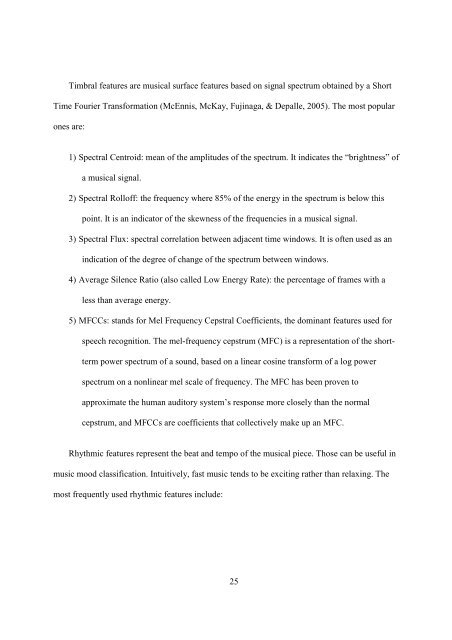improving music mood classification using lyrics, audio and social tags
improving music mood classification using lyrics, audio and social tags
improving music mood classification using lyrics, audio and social tags
Create successful ePaper yourself
Turn your PDF publications into a flip-book with our unique Google optimized e-Paper software.
Timbral features are <strong>music</strong>al surface features based on signal spectrum obtained by a Short<br />
Time Fourier Transformation (McEnnis, McKay, Fujinaga, & Depalle, 2005). The most popular<br />
ones are:<br />
1) Spectral Centroid: mean of the amplitudes of the spectrum. It indicates the “brightness” of<br />
a <strong>music</strong>al signal.<br />
2) Spectral Rolloff: the frequency where 85% of the energy in the spectrum is below this<br />
point. It is an indicator of the skewness of the frequencies in a <strong>music</strong>al signal.<br />
3) Spectral Flux: spectral correlation between adjacent time windows. It is often used as an<br />
indication of the degree of change of the spectrum between windows.<br />
4) Average Silence Ratio (also called Low Energy Rate): the percentage of frames with a<br />
less than average energy.<br />
5) MFCCs: st<strong>and</strong>s for Mel Frequency Cepstral Coefficients, the dominant features used for<br />
speech recognition. The mel-frequency cepstrum (MFC) is a representation of the shortterm<br />
power spectrum of a sound, based on a linear cosine transform of a log power<br />
spectrum on a nonlinear mel scale of frequency. The MFC has been proven to<br />
approximate the human auditory system’s response more closely than the normal<br />
cepstrum, <strong>and</strong> MFCCs are coefficients that collectively make up an MFC.<br />
Rhythmic features represent the beat <strong>and</strong> tempo of the <strong>music</strong>al piece. Those can be useful in<br />
<strong>music</strong> <strong>mood</strong> <strong>classification</strong>. Intuitively, fast <strong>music</strong> tends to be exciting rather than relaxing. The<br />
most frequently used rhythmic features include:<br />
25
















